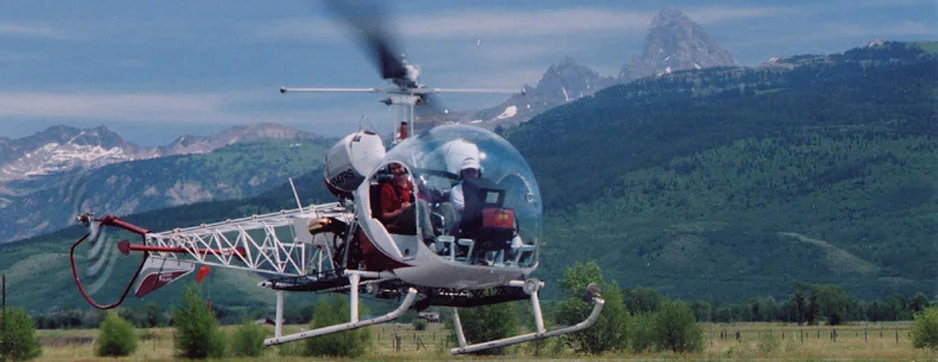
Bell 47 Helicopter
The Bell 47 was the first helicopter certified for civilian use, on 8 March 1946. It was mostly designed by Arthur M. Young, who joined Bell Helicopter in 1941. More than 5,600 were produced until 1974, including 1,200 under license in Italy, 239 in Japan, and 239 in the UK.
The Bell 47 helicopter entered U.S. military service in late 1946, in a variety of versions and designations for three decades. In the Korean War (1950-1953) it was designated the H-13 Sioux by the United States Army, a highlight of its extensive career. It has also served as the helicopter of choice for basic helicopter flight instruction in many countries.
Early models were variable in appearance, with open cockpits or sheet metal cabins, covered or open structures, some with four-wheel landing gear. Model D and Korean War types settled to a more utilitarian style. The most common model, the 47G introduced in 1953, can be recognized by the full bubble canopy, exposed welded-tube tail boom, saddle fuel tanks, and skid landing gear.
Later 47H and 47J Ranger models had a regular cabin with full cowling and monocoque tail boom. Engines were Franklin or Lycoming horizontally-opposed piston engines of 200 to 305 HP (150 to 230 kW). Seating varied from two to four. Many are still in use as trainers and in agriculture (as of 2005).
NASA had a number of Bell 47s during the Apollo program, used by astronauts as a trainer for the Lunar Lander. Eugene Cernan had a near disastrous accident shortly before his flight to the moon on Apollo 17 by crashing one into the Indian River.
Initially, the US Navy procured several Bell 47s, designated HTL-1, between 1947 and 1958. The US Coast Guard evaluated this model, and procured two HTL-1s for multi-mission support in the New York Harbor. The most common US Navy version of the 47 was designated the HTL-4, and dispenses with the fabric covering on the tail boom. The US Coast Guard procured three HTL-5s in 1952 (similar to the HTL-4 but powered by a Franklin 0-335-5 engine) and used these until 1960.
The Coast Guard procured two of Bell’s Model 47G and designated them HUL-1G in 1959.
The British version of the 47G, called by the British Army the Sioux AH.1, was built by Westland Helicopters for use by the Army Air Corps, who used it until the early 1980s. The Sioux military version was often equipped with military evacuation panniers, one to each skid, with an acrylic glass shield to protect the patient from wind.
H-13 were produced in Japan by a Bell and Kawasaki venture; this led to the Bell-Kawasaki KH-4 variant, essentially a three seat version of the Model 47.
Bell built more than 4,000 47s between the late 1940s and 1974. AgustaBell of Italy licence built over 1200; Kawasaki of Japan 239; and Westland of the UK 239.
SPECIFICATIONS
Manufacturer - Bell Helicopter
Model - BHT-47-G3
Serial # - 2636
Year - 1961
N-Number - N147RS
Engines - One, vAllison C-18v Thrust: 550 HP
Length - 31’ 7”
Height - 8’ 7”
Wingspan - 9’ 3”
Weight -
Empty: 1,911 lbs.
Max Takeoff: 2,950 lbs
Performance -
Range: 200 Miles
Ceiling: 16,000’
Max Speed: 105 kts












